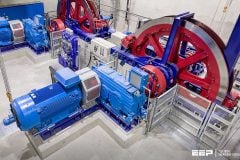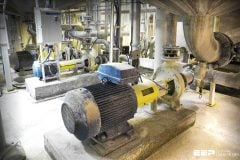Softstarter parameters
This technical article includes a short description of six common setting parameters available on most of the softstarters. Other settings may be available depending on the type of softstarter and manufacturer.

The setting can be done either by adjusting potentiometers, changing dip switches, using a key pad, a computer or similar and
1. Start ramp
Start ramp is the time from were the softstarter start its ramp (initial voltage) until full voltage is reached. The ramp time should not be too long, as this will only result in unnecessary heating of the motor and a risk of the overload relay to trip.
If the motor is unloaded the start time for the motor will probably become shorter than the set ramp time, and if the motor is heavily loaded, the start time will probably become longer.
Go back to Softstarter Settings ↑
2. Stop ramp
Stop ramp is used when a soft stopping of the motor is required, for example a pump or a conveyor belt. The stop ramp is the time from full voltage until stop voltage (initial voltage) is reached.


Go back to Softstarter Settings ↑
3. Initial voltage
Sometimes named pedestrian voltage or torque, this is the point from where the softstarter starts or stops its ramps. The torque of the motor will drop with the square of the voltage and if the voltage is set too low, for example 20 %, the starting torque will become 0.22 = 0.04 = 4 % only, and the motor will not start from the very beginning.
Go back to Softstarter Settings ↑
4. Current limit
Current limit can be used in applications where a limited starting current is required, or at a heavy-duty start when it is difficult to achieve a perfect start with the setting of the initial voltage and the start ramp only.
When the current limit is reached, the softstarter will temporarily stop increasing the voltage until the current drops below the set limit, and then continues ramping up to full voltage.
Note that this feature is not available on all softstarters!


Go back to Softstarter Settings ↑
5. Step down voltage
Step down voltage gives a special type of stop ramp. It is possible to adjust the voltage to drop to a level where the speed of the motor starts to reduce immediately at the stop command.


Go back to Softstarter Settings ↑
6. Adjustable rated motor
Adjustable rated motor current makes it possible to set the motor rated current on the softstarter for the used motor. This setting may affect other values as well, such as the trip level of the electronic overload relay, the level of the current limit function and so on.
Go back to Softstarter Settings ↑
How to set up your PSTX softstarter in 30 seconds
Go back to Softstarter Settings ↑
How to do setting for 1speed softstarter PSE model
Go back to Softstarter Settings ↑
Reference // Softstarter Handbook by ABB











Hi, I have a motor rated at 440V, can we use a 230v rated softstarter with the same kva rating?
Morning
Hi i have installed 290 KW, 550 V pump controlled with a Soft Starter at a distance of 50 km and when we relocated the pump to a distance of 150 km is dropping voltage from 550 V to 375 V and Soft Starter trips with under voltage. What can i do to avoid voltage drop to a distance of 150 km
It is very much helpful still more information required
Good especially about soft starter programming
I want to run more about soft starter programming